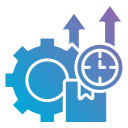Implementing Tools to Boost Remote Productivity
Working remotely has become the new norm for many professionals and organizations worldwide. The key to thriving in this environment lies in adopting and integrating the right digital tools that can enhance efficiency, foster collaboration, and streamline everyday tasks. From robust communication platforms to advanced project management solutions, the thoughtful implementation of productivity tools is essential for overcoming the challenges of remote work. This comprehensive overview will guide you through the strategies and solutions available to help remote teams stay connected, focused, and productive.
Previous
Next
Integrating Tools into Team Workflows
Automation and Workflow Optimization
Automation is the key to relieving teams from the burden of repetitive, manual tasks. By integrating automation tools with existing systems, teams can automate everything from task assignments to status updates, freeing valuable time for higher-priority activities. Automation not only increases productivity but also reduces the risk of errors associated with manual data entry and task management. For remote teams, where tracking and accountability can be more challenging, automation ensures no task falls through the cracks, supporting consistency and quality across projects.
Cross-Platform Compatibility
With remote teams often using a diverse array of devices and operating systems, cross-platform compatibility is critical. Implementing tools that operate smoothly across desktops, laptops, tablets, and mobile devices ensures all team members have equal access, regardless of their hardware or location. This capability keeps everyone on the same page and maintains productivity when transitioning between different work environments. Selecting tools specifically designed for cross-compatibility leads to smoother communication and workflow, minimizing downtime caused by technical issues.
Training and Onboarding
Effective use of digital tools depends on the team’s familiarity and comfort level with the technology. Investing in comprehensive training and onboarding equips employees with the knowledge they need to utilize each tool to its fullest potential. Whether via guided tutorials, live workshops, or self-paced learning modules, training reduces resistance to technological change and fosters a digital-first mindset. Continuous learning opportunities allow team members to stay updated as tools evolve, ensuring the team consistently benefits from the latest features and best practices.
Overcoming Common Challenges in Remote Productivity
Combating Digital Fatigue
Constant virtual meetings and continuous connectivity can lead to digital fatigue, eroding focus and motivation. To address this, organizations should implement tools that offer customizable notification settings, support asynchronous communication, and encourage scheduled breaks. Empowering employees to manage their online availability, rather than feeling compelled to respond instantly, helps foster a healthier relationship with technology. Encouraging video-off meetings or adopting tools that minimize screen time can further alleviate fatigue and support sustained productivity.
Managing Information Overload
Remote work often increases the volume of information workers must process daily. This can quickly lead to confusion, missed updates, and stress. To mitigate this, organizations should implement tools with powerful filtering, search, and organizational capabilities. Smart tagging, centralized dashboards, and customizable reporting can help employees prioritize important messages and updates, reducing cognitive overload. Simplifying communication channels and establishing clear guidelines for information-sharing ensures that everyone receives only what is relevant to their role.
Fostering Team Connection and Culture
The absence of physical proximity can diminish team spirit and cultural cohesion. To bridge this gap, organizations should leverage tools that facilitate informal interaction, virtual events, and recognition programs. Platforms with features for celebrating milestones, sharing feedback, and hosting casual catch-ups create opportunities for relationship-building. Encouraging the use of social channels or digital coffee breaks helps maintain a sense of belonging, ensuring remote employees feel valued and connected to the organization’s mission and each other.
